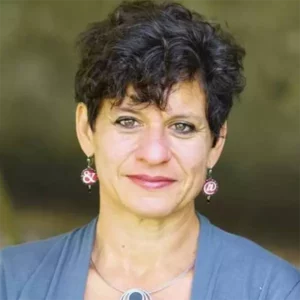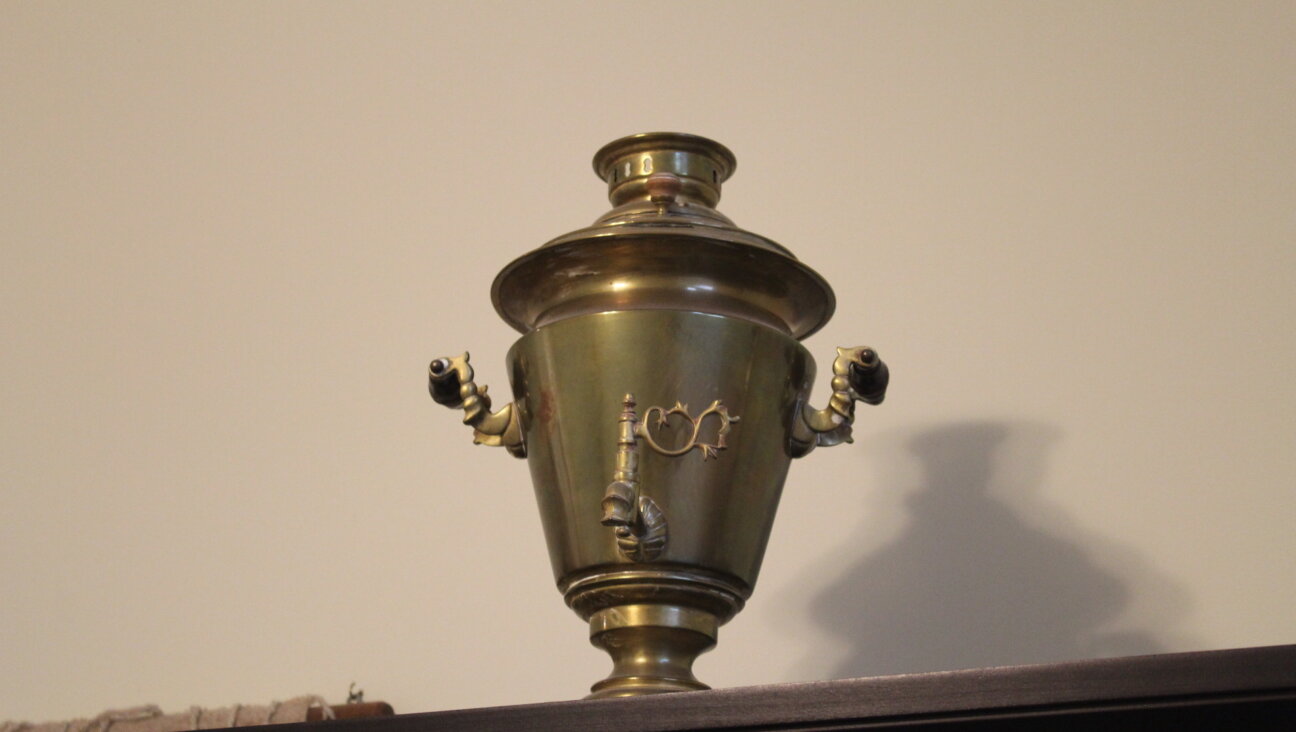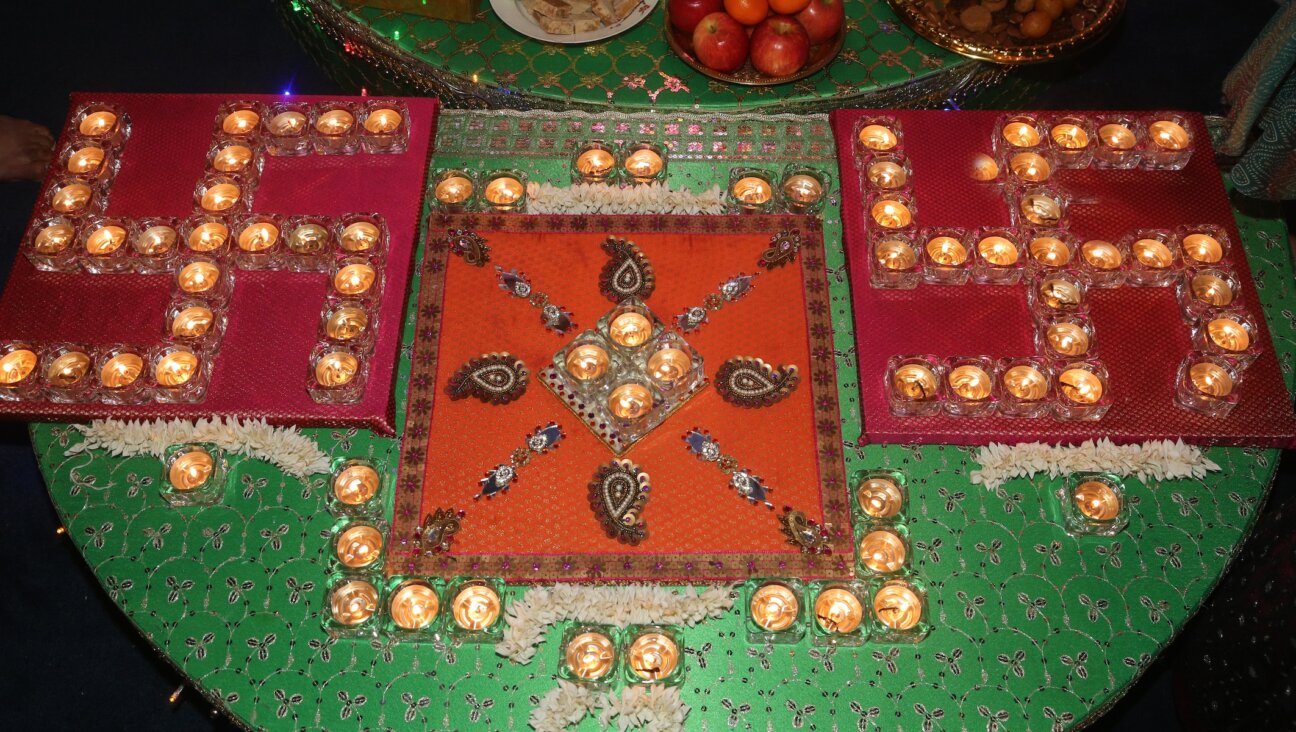A mile from the DNC, a giant pair of bloody sweatpants evokes the horror of Oct. 7
But Chicago’s popup ‘hostage square’ seems to be an exercise in preaching to the converted
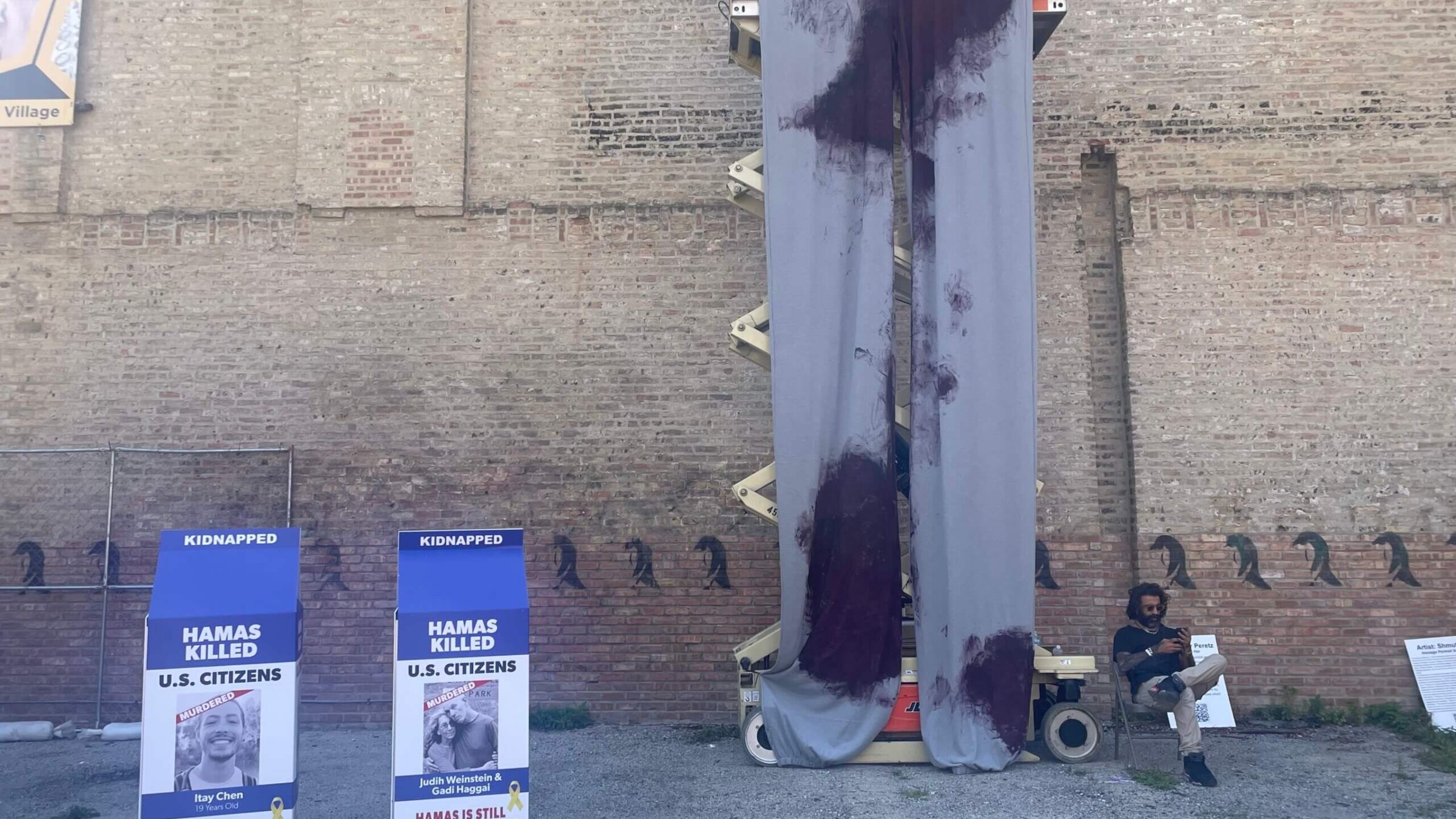
A mile from the DNC, a tribute to the Israeli hostages features a 22-foot replica of the bloody sweatpants worn by 19-year-old Naama Levy, one of the 100-plus Israelis still in captivity in Gaza. Photo by Jodi Rudoren
CHICAGO — You can glimpse part of Tomer Peretz’s artwork from the street, but not really make out what it is; gray fabric splattered with paint flapping in the summer breeze a few feet from a wall of beige brick here in Chicago’s West Loop.
To really see it you have to walk inside the fenced-off lot festooned with Israeli and American flags, let the security guard check your bag and go through the metal detector. You have to pass by the giant milk cartons depicting some of the people killed and abducted by Hamas terrorists on Oct. 7 and the charcoal sketches of the same victims hung on clotheslines under yellow balloons.
As you approach, you will see that the gray fabric is gathered with elastic at the bottom like sweatpants, and then you realize the splattered acrylic paint is meant to evoke blood. This is a 22-foot replica of the bloody sweatpants worn by 19-year-old Naama Levy, one of the 100-plus Israelis still in captivity in Gaza, in a video that went viral on Oct. 7 as one of the earliest hints of the sexual violence committed as part of the massacre.

“The idea is to touch people’s emotions and to stab them a little in the heart and the stomach,” Peretz, who grew up in Jerusalem and lives in Los Angeles, told me.
“When people see clothing with blood, it shrinks them, it makes them ask what it is,” he added. “If you drive downtown Chicago right now, you will see a lot of billboards and ads for clothing. Everything is so clean and so beautiful and so fashionable. The idea here is to create something that is a contrast. I see darkness right now, and I think it’s OK to show the darkness.”
Peretz, 42, is one of several artists who the Israeli-American Council and a local real estate investor named Jeff Aeder flew into Chicago for this makeshift “hostage square” exhibit about a mile from the United Center, where the Democratic National Convention is taking place.
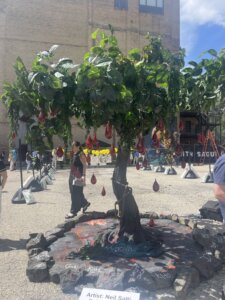
Elan Carr, chief executive of the pro-Israel group, said the group decided to stage the exhibit after its applications for permits to assemble near the convention site or march around it were denied. Aeder said that he rented the fenced-in lot at the corner of West Madison and South Morgan streets from a friend for $1. It is a one-day pop-up experience.
Neither man would say how much they spent on the project, beyond “a lot,” as Aeder put it.
The location of the exhibit was not announced publicly for fear of attracting protesters. To see it, you had to sign up in advance, and Carr said the group capped signups at 800. Attendance when I stopped by from 1 to 2 p.m. on Tuesday was sparse — organic visitors seemed outnumbered by security personnel, volunteers in “Bring Them Home” T-shirts and journalists.
And most of those outnumbered visitors wore yellow-ribbon lapel pins and hostage dog-tags, making the whole thing feel like an exercise in preaching to the converted.
Earlier, the parents of one of the hostages, Omer Neutra, were on site and briefing the press; as I left, U.S. Rep. Brad Schneider, who represents the heavily Jewish northern suburbs of Chicago, showed up.
“We’re still in our echo chamber here,” acknowledged Peretz, who has a mop of curly hair, funky glasses and a hoop earring. “I wish I could put it in the middle of the DNC.”
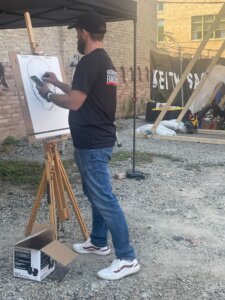
Peretz, who lives in the San Fernando Valley with his three children, was visiting relatives in Israel on Oct. 7. He joined up as a volunteer with Zaka, the first-responders’ group, and was “clearing bodies on Kibbutz Beeri” on Oct. 9 when he first saw the video of Levy in her bloody sweatpants being dragged by her hair onto a terrorist’s Jeep. “This image was stuck in me,” he said.
So a few months ago he created three giant replicas of the sweatpants, commissioning a clothing manufacturer in Guatemala to stitch the gray fabric together. “By hands, no machine,” he noted. One pair has been hanging on a building on Sepulveda Boulevard, a busy thoroughfare in the Valley. The pair on display here is meant to travel the country or the world.
And the third pair, which does not have the “blood” spattered, has been painted on by some 200 survivors of Oct. 7. “The third one is with the light and the hope on it,” Peretz said.
That project is part of “8,” a group Peretz created to help survivors cope with their trauma through art. He said the number 8 has always resonated with him — he has it tattooed on several parts of his body — because it looks like the infinity symbol and because, after the seven days of creation in Genesis, “on the eighth day we started to live.”
It also is the number of American-Israelis who remain hostages in Gaza. And it represents the idea of Oct. 8, of what happens after the nightmare, of moving on. Sort of.
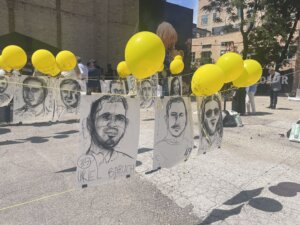
“Since the beginning of the war, it’s been only about the war — it’s the only thing I can create about,” Peretz told me. “Nothing else interests me. It’s all my life right now.”
Another of Peretz’s projects, large black banners with the first names of the eight American-Israeli hostages in white block letters, is also on display here. ITAY. HERSH. OMER. GADI. SAGUI. JUDY. KEITH. EDAN.
I asked Peretz what the reaction to these artworks have been from other artists in Los Angeles — does he feel pressured by the left over his focus on the hostages versus the suffering in Gaza?
“I don’t know so much about politics and the left and the right,” he shrugged. “I don’t deal a lot about facts. I’m focused on touching people’s emotions and make them feel something and do their own investigations.”
First, of course, they have to see it.
Correction: An earlier version of this article misstated the name of an American-Israeli hostage held in Gaza. His name is Omer Neutra, not Omar Neutra.
